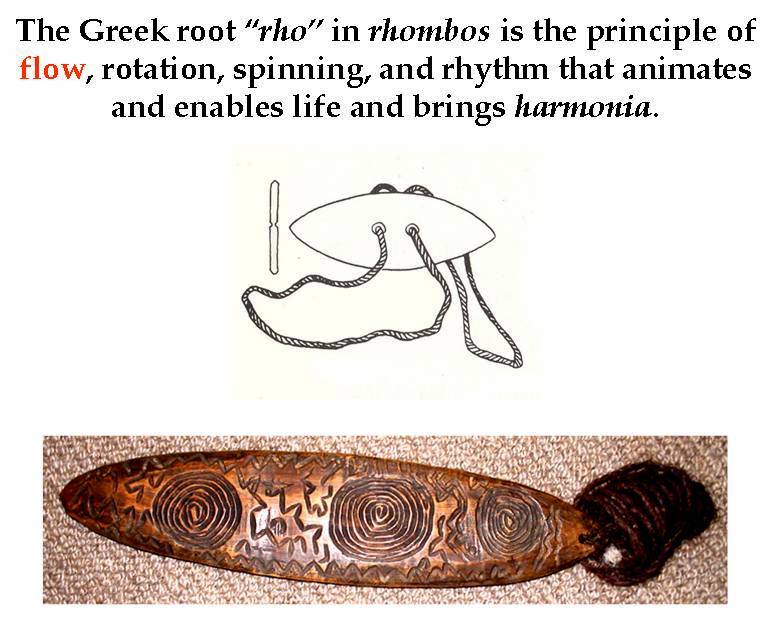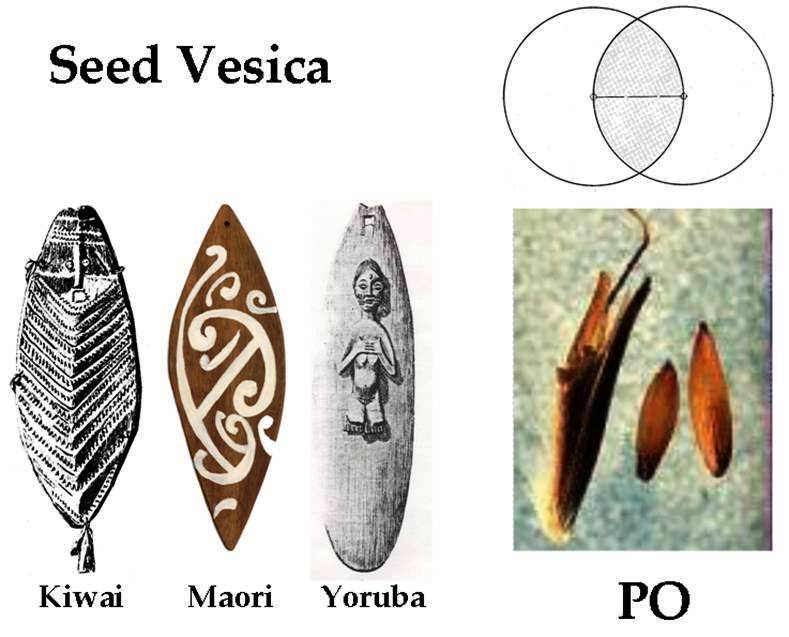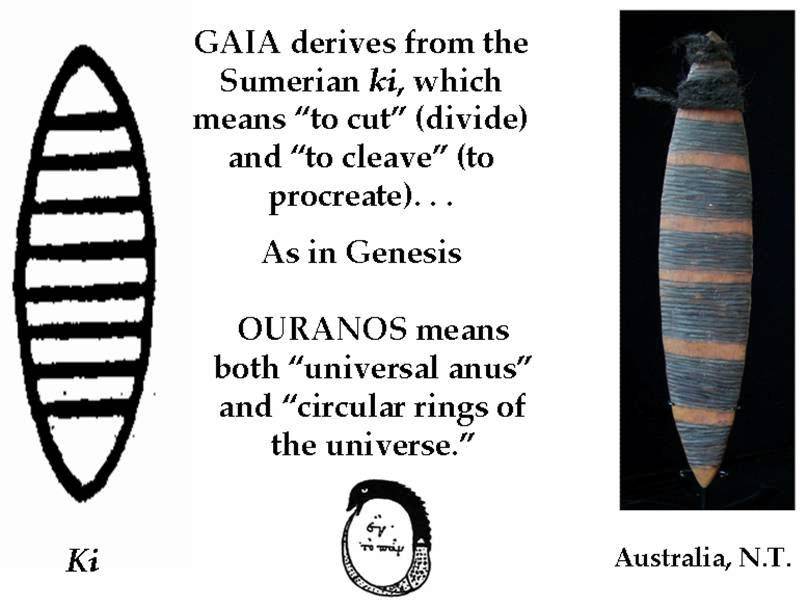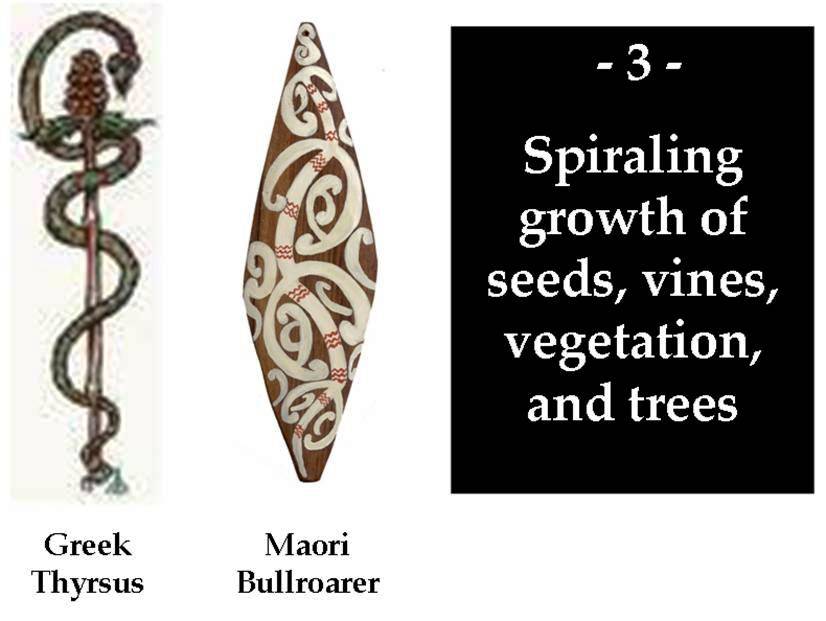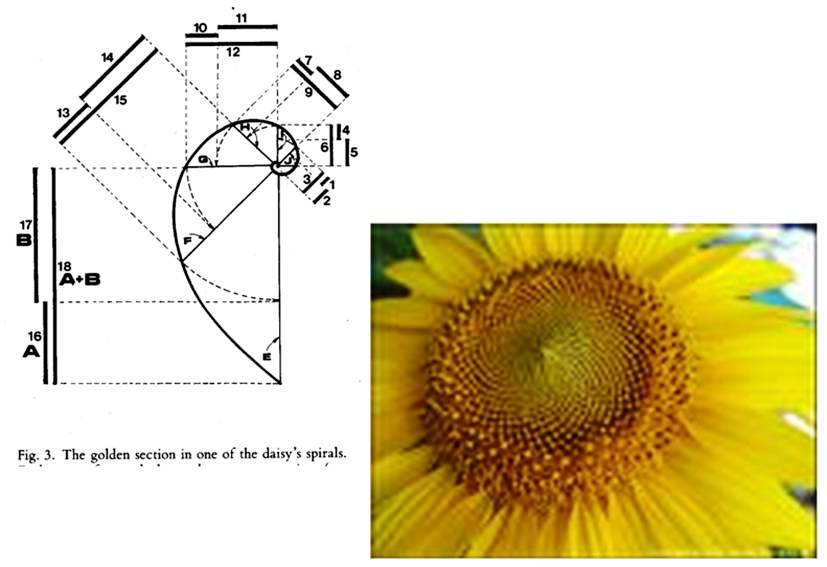SPIN as CREATIVE CONSCIOUSNESS
by Bethe Hagens
bethehagens@gmail.com
April 2009, Annual Spring Meeting, Society for the Anthropology of Consciousness
Abstract [Slide 1]
The bullroarer and buzzer were once well-known and well-loved by anthropologists. They functioned within the profession as ?hallmark artifacts? that symbolized the cultural relativist commitment to independent invention even as evidence (size, shape, meaning, uses, symbols, ritual) stretching tens of thousands of years across human history pointed to diffusion. In virtually every part of the world, even today, these artifacts continue to be ?invented? and re-symbolized in many of the ancient ways. This graphic, experiential presentation draws from twenty years of fieldwork and literature search, as well as six years art-based research in which I used hand tools and a worldwide sample of woods to carve several hundred reproductions of these instruments from nearly as many ?separate? cultural identity traditions. I will propose a transpersonal experience of ?spin? which is independently discovered, experienced (e.g. via infrasound, manufacture, observation of sky and landscape), and witnessed as connective to larger creative consciousness.
[Slide 2] The bullroarer, often identified as both the earliest human toy and the first musical instrument , has a verified existence in Magdalenian era France (30,000 BCE), Çatalhöyük (ca. 7000 BCE), and King Tutankhamun's tomb (ca. 1000 BCE). It apparently has remained in continuous use across human cultures to engage in play as well as to ?call? the Creative to practical personal, social and environmental problems. [Slide 3]
Bullroarers and buzzers [Slide 4] (which, when they are circular, are called magic wheels of Hecate ) are physical tools of the liminal and used to cross a threshold [Slide 5] analogous to what Darwinian science might term a punctuated equilibrium. Their sound signals and intends that a situation-specific change of consciousness toward the good of all has occurred.
Sickness >>> Healing
Pain >>> Relief
Drought >>> Rains
Boredom >>> Play
Chaos >>> Solution
Not-in-Love >>> In Love
Danger >>> Safety
Wrong >>> Right
Child >>> Adult
Seed >>> Germination
Hunger >>> Sustenance
Single >>> Married
Not Pregnant >>> Pregnant
Death >>> Afterlife
Ordinary >>> Not Ordinary
[Slide 6] Play appears to be critical to developing an experienced sense of creative flow (Csikszentmihalyi), and bullroarers and buzzers reinforce flow [Slide 7] by generating continuous spiraling vortex timbres (rhythmic, monotonous spin pulsings) that establish sonopoetic spaces (architectures composed of sound that are individually experienced and culturally situated). [Slide 8] At an unpredictable moment after the swinging or spinning begins, when the strings wind tightly enough, the bullroarer begins to whirr and the magic wheel begins its heavy sexualized breathing. [Slide 9] That moment is the liminal threshold. Rhythmically, approximately every 5 seconds or so, as with breath, the sound stops as torque on the strings stops the spin of the instrument for an instant. It vocalizes again as the string begins to unwind and the instrument spins in the opposite direction.
[Slide 10] The range of sizes, shapes, carvings, notchings, and weights of bullroarers generate a banquet of sounds. Possibly some resonances create infrasounds?frequencies below 20 hz. that match brainwaves and planetary frequencies, detected not by the ears but by the midbrain. The specific effects of these shaped timbres appear to have been discovered and rediscovered across our species history.
[Slide 11] This archetypal timbre of breath which carries the voice of Creator is a living thing, not merely metaphor. It is really planetary breath, synonymous with all-encompassing mysteries of metamorphosis?birth, growth, fertility, sexuality, swallowing, excretion, decay, death, rebirth. . . Breath?or wind?is in this way a fertilizing and consuming/cleansing principle. The pulsed spinning of the bullroarer or magic wheel breathes?or rather, is ?the timeless connection between Ancestral Being and human being.
The timbre of the instruments, then, are the creative energies of spin as axis and as plane. As sonopoetic space, breath unites all creative cosmic spinners?be they weavers, potters, dervishes, fire-makers, cyclones, or stars and planets. All of them analogously enact the drama known in classic Greek mythology as the tasks of the Moirae: the three Fates who spin, weave, and snip the thread of life?of breath. The point I am making is that timbre is not something detached and disembodied. It is sonopoetic imagery experienced, mirrored, and echoed in every single inhalation and exhalation an individual makes.
Used in consort?and in Papua New Guinea, hundreds of bullroarers were traditionally swung to create wave effects during initiation rituals?these instruments can be thought of as community magic utilities that safely mediate spiraling, transformative energy in sonopoetic (culturally controlled) safe space. An entire lifetime in bullroarer timbre brings ever more subtle, highly personalized experiences and understandings of social and mystical dimensions of ecstasy, fear, talent, lust, pain, deprivation, ethics, and oneness of body in cosmos. Of flow.
If the space is safe, the instruments themselves are not. . .exactly, but are regarded with a certain wariness characteristic of sympathetic magic?possibly the recognition of the unpredictability and potential for personal danger in situations requiring bullroarer intervention. One would not like to invite sickness, infertility, or lost love by associating too casually with that which calls it away.
If the bullroarer vocalizes change, its companion the buzzer (or magic wheel) breathes life into new being. Both instruments are symbolically alive today in religion, myth, philosophy, and ritual practice in all parts of the world. Witness the present fascination in the West with crop circles, labyrinths, DNA, earth energy vortexes. But their meanings are disconnected and fragmented. How can we reconnect this panhuman ecological vision, re-experience being swallowed, consumed, excreted by the spin of the universal cosmic spiral, Ouroboros? And at the same time, avoid, as Heron has written, creating perennial truths ?in vain denial of the inherent unpredictability of the divine womb of time.?
I'm proposing that the sonopoetic space of spin vortexes created by bullroarers and magic wheels is a connective enactment of the living, dynamic energy of spin that inhabits the psyche, the body, the cosmos, and more particularly, the immediate physical environment that we are beginning to see again in old ways as we reinvent a Gaia in pain from globalization. Four such environmental manifestations of the archetype of spin very closely match the sonopoetic ritual spaces and symbolic domains of bullroarers and magic wheels.
[Slide 12] (1) The spinning of Earth on its polar axis, visualized as circling stars, planets, sun, and moon. Hamlet's Mill (Santillana and Von Dechend) extensively argues for ancient cross-cultural transmission through myth of daily polar spin and the 26,000-year gyroscopic wobble of earth's axial pole using explicitly sexual, generative imagery of a grinding mill: Pole (power, penis) grinding Earth in spin. The fish-shaped bullroarer of the Dogon of Mali, for one example, is Po . ( [Slide 13] The Greek word for bullroarer, rhombos, also means fish, penis, rhomb, and womb.) [Slide 14] Po is the name as well for a grass seed (fonio) that traditionally provided the Dogon with their main sustenance. The Dogon swing the bullroarer in a metaphor of broadcast seeding Po . Imagine a world in which grass is a miracle analogous to the task of the bullroarer. Natural theologian Paley wrote in 1802: ?Their [grass's] extraordinary means and powers of preservation and increase, their hardiness, their almost unconquerable disposition to spread, their faculties of reviviscence, coincide with the intention of nature concerning them.? At the two places where the spinning plane of sun, moon, and planets (the ecliptic zodiacal belt) is crossed by the spinning plane of the Milky Way, the Dogon see two cosmic granaries that connect them to ancestors. Po is also a powerful power dark star they believed orbits the brightest star in the sky, Sirius. [Slide 15] In IndoEuropean lore, Sirius is ?The Roarer.?
[Slide 16] A complete solar eclipse is another phenomenon of polar spin, and a source of chaos and fear, because sun and moon appear to be moving in opposition directions along a single vortex plane. As moon ?eats? the sun, an obsidian blade bullroarer initiates and closes the action. In Aztec cosmology, the mother creator is impregnated by the obsidian blade and gives birth to the moon.
[Slide 17] (2) Cyclones, hurricanes, tornados, whirlwinds, and waterspouts. These unpredictable, powerfully destructive phenomena of the cyclic flow of wind and water are experienced across most of the earth. Whirlwinds, the least problematic, appear in myth as the agent of impregnation, and in some stories, a woman gives birth to the bullroarer itself as she brooms her floor for dust.
Across traditions, the bullroarer's timbre is most consistently likened to distant thunder, or the weird roar of wind during a storm or hurricane. [Slide 18] The most common image cut into or painted upon a bullroarer is a snake merged into a lightning bolt. Imagine a mammoth spiraling hurricane or cyclone reaching land and, as is so often the case, spinning off groups of smaller tornados, lightning flashing up and down their funnels. [Slide 19] In eastern Australia , the most common name for the bullroarer is turndun . Like consorts of turnduns , minor tornados may turn back upon each other and merge into a roaring monster.
[Slide 20] Hesiod writes in Theogony that Gaia bore to Ouranos the Cyclopes, who gave Zeus thunder and lightning bolts; and the Hecatonkheires, who may symbolize earthquakes and some aspect of Hecate, for whom the magic wheel is named. In all else they were like gods, but one eye only was set in the midst of their foreheads. As soon as each was born, Ouranos forced them back into Gaia's womb, causing her great pain. [Slide 21] Ultimately Gaia released the vortexes by castrating Ouranos with an obsidian blade. This cutting of genitalia, and the splitting of the body with a bullroarer-blade to sustain larger energies of life energy, is found in widely separated mythological traditions from Greek to Aztec to 19 th century peoples in south east Australia.
[Slide 22] Spiraling growth of seeds, vegetation, and trees. One of the most common forms of the bullroarer is an elongated seed shape, reminiscent of the eclipse vesica. [Slide 23] The bullroarer Tecpatl , the Aztec obsidian knife of sacrifice activated into spin by Ollin , the buzzer, hybridizes ?seed,? fish, and tongue. [Slide 24]
[Slide 25] Fascination with the spiral of golden mean rectangles and Fibonacci numbers in seed patterns of plants such as the sunflower connect living vortex energies to human rationality: to a sense of purpose. Leaves emerge around a stem along a predictable regular spiral, as do branches from the trunk of a tree. In many traditions, bullroarers wait to be set free from inside of a tree. Spiraling tendrils emerge from vines such as peas to cling to support structures at exactly the moment the plant needs them. [Slide 26] Clusters of supporting tendrils, like consorts of bullroarers, can ultimately enable the emergence of a huge, choking, spiraling string-like vine.
[Slide 27] Spiraling flight paths of birds of prey. Bullroarers are swung at death, to encourage Ancestors who will call the spirit of the deceased away from the living. Eagles and hawks, circling birds of prey who survive primarily on dead meat, are prominent in bullroarer mythologies.
[Slide 28] To summarize all of this, the iconography and meanings of bullroarers and buzzers worldwide is interwoven seamlessly with natural consciousness-altering phenomena?from the healing buzzing of hummingbird's wings (a mythology related to the bullroarer Ishe (voice of Osain) in Ifa/Kari Osha/Santeria traditions, for example) to the fear, awe or sheer terror produced by infrasonics in thunder, lightning, earthquakes, tsunamis, tornadoes, or herds of buffalo.
Most notably, Tuzin has proposed that bullroarers actually generate infrasonics. Fletcher, Australia 's most prominent acoustic scientist and investigator of bullroarers, believes that rather than creating true infrason, the pulsations of a bullroarer indirectly stimulate brain rhythms below 20 hz. (which causes psychological effects and concentrates perception) because the frequency of the basic bullroarer sound (approximately 100-110 hz.) is so low and has no upper partials (harmonics) to distract attention. 110 hz. is an exact harmonic frequency of 440 hz., the ?A? to which orchestras tune today. Cook et al. propose that 110 hz. is a threshold resonance frequency in megalithic architectural structures for relative deactivation of language centers and a shift in prefrontal activity that may be related to emotional processing.
In these ways, the bullroarer hybridizes the human with cosmos?the sonopoetic (cultural, biological, personal) space of emotion, metaphor, and liminal creation as the living archetype of spin.
References
American Association for the Advancement of Science. 1890. Science 15 . Moses King, Publisher.
Baal, J. van. 1963. The cult of the bull-roarer in Australia and southern New Guinea . Bijdr. Taal- , Land- Volkenk 119:201-214.
Brundage, B. C. 1979. The fifth sun: Aztec gods, Aztec world . Austin : University of Texas Press.
Cook, I. A., S. K. Pajot, and A. F. Leuchter. 2008 Ancient architectural acoustic resonance patterns and regional brain activity. Time and Mind: The Journal of Archaeology, Consciousness and Culture 1: 95-104.
Csikszentmihalyi, M. 1990. Flow: The psychology of optimal experience . New York : Harper & Row Publishers, Inc.
Doczi, G. 1981. IThe power of limits: Proportional harmonies in nature, art and architecture. Boulder : Shambhala.
Edinger, Edward. 1999. Archetype of the apocalypse: A Jungian study of the Book of Revelation . Chicago : Open Court .
Fletcher, N., A. Z. Tarpolsky, and J. C. S. Lai. 2002. Rotational aerophones. Journal of the Acoustical Society of America 11:1189-1196.
Fletcher, N. Personal communication. February 20, 2005 .
Gow, A. S. F. 1934. Iynx, rhombos, rhombus, turbo. The Journal of Hellenic Studies :1-13.
Haddon, A. C. 1898. The study of man . New York : G. P. Putnam's Sons.
Hagens , B. 2005. Timbres of the Spheres: The Bullroarer and the Magic Wheel. In Proceedings: Conference Internationale Musicologique , edited by C. Traube and S. Lacasse. OICM/UMontreal. Electronic document, www.oicm.umontreal.ca/cim05/cim05_articles/HAGENS_B_CIM05.pdf
______ . 2004 Bullroarers. Berkshire Encyclopedia of World History . Boston : Berkshire Publishing Group.
Hall, R. L. 1983. A pan-continental perspective on red ocher and glacial kame ceremonialism. In Lula linear punctated: Essays in honor of George Irving Quimby , edited by R. C. and D. K. G. Dunnell. Ann Arbor : University of Michigan Museum of Anthropology .
???. 1985a. Cognitive cores and flint flakes. In The life of symbols , edited by M. L. Foster and L. J. Botscharow. Boulder , San Francisco & Oxford : Westview Press.
Heron, J. 1998. Sacred science: Person centered inquiry into the spiritual and the subtle. Ross-On-Wye , UK : PCCS Books.
Johnston , S. I. 1990. Hekate soteira: A study of Hekate's role in the Chaldean Oracles and related literature . Vol. 21, American Classical Studies .
Lang, A. 1910. Bull-Roarers. In Encyclopedia of Religion and Ethics ,edited by J. A. Selbie. 2:889-891.
Lahood, G. 2008. Paradise bound: A perennial tradition or an unseen process of cosmological hybridization. Anthropology of Consciousness 19(2):155-189.
Lauffer, D., and P. Williams. 2007. Seed embryo. Wisconsin Fast Plants®. Retrieved March 25, 2009 from Wisconsin Fast Plants Web site: www.fastplants.org
Loeb, E. M. 1929. Tribal initiations and secret societies. University of California Publications in American Archaeology and Ethnology 25 (3):249-288.
Mathews, R. H. 1896-1897. The Keeparra ceremony of initiation. The Journal of the Anthropological Institute 26:320 - 340.
Morley, I. 2006. The Evolutionary Origins and Archaeology of Music. Darwin College [ Cambridge University ] Research Report DCRR-002. Cambridge University . Accessed March 20, 2009 www.dar.cam.ac.uk/dcrr
Paley, W. 1802 (1837) Natural Theology. Edited by T. Smibert. Edinburgh : William and Robert Chambers.
Puterbaugh, J. 1999 Between a place and some location: A view of timbre through auditory models and sonopoietic space. Dissertation, Princeton University .
Salvatore, G. 1991. Can archetypes be heard? Musicworks 49 (Winter).
Santillana, G. de and H. von Dechend. 1969. Hamlet's mill . Boston : Gambitt, Inc.
Tavenner, Eugene. 1933. Iynx and rhombus. Transactions and Proceedings of the American Philological Association 64:109-127.
Tuzin, D. 1984. Miraculous voices: The auditory experience of numinous objects. Current Anthropology 25 (5):579 - 596.
Waller, S. J. 2004 Rock art acoustics: Steven J. Waller's rock art acoustics page 2004 [cited October 21] http://www.geocities.com/CapeCanaveral/9461/ .
Williams, Francis E. 1936. Bull-roarers in the Papuan Gulf . Vol. 17, Government Anthropologist . Port Moresby : Walter Alfred Bock.
Zerries, Otto. 1942. Das schwirrholz: untersucjung uber die verbreitung und bedeutung der schwirrholz im kult . Stuttgart : Strecker and Schroder.
Slide 1 |
|
Slide 2 |
|
Slide 3 |
|
Slide 4 |
|
Slide 5 |
|
Slide 6 |
|
Slide 7 |
|
Slide 8 |
|
Slide 9 |
|
Slide 10 |
|
Slide 11 |
|
Slide 12 |
|
Slide 13 |
|
Slide 14 |
|
Slide 15 |
|
Slide 16 |
|
Slide 17 |
|
Slide 18 |
|
Slide 19 |
|
Slide 20 |
|
Slide 21 |
|
Slide 22 |
|
Slide 23 |
|
Slide 24 |
|
Slide 25 |
|
Slide 26 |
|
Slide 27 |
|
Slide 28 |
|
These files are protected by a Creative Commons license. Any of the information and graphics may be copied and freely shared as long as (1) the author and source are cited; (2) the Creative Commons license is acknowledged; and (3) the material is not sold. Please contact me if you have a question about using any of these materials.





